Parking Management Plan
Purpose
This Parking Management Plan for East Dunbartonshire has been produced following an extensive process to develop the Local Transport Strategy 2020- 2025.
The requirement for this Parking Management Plan was identified through this process and therefore allows this plan to deliver on the Local Transport Strategy by drawing on the evidence and detailing the Council approach to managing the issues which have been identified. The Transport Planning Objectives and Action 26 related to parking are summarised below at Local Transport Strategy 2020-2025. Read the Local Transport Strategy.
The content of this Parking Management Plan includes a review of roles and responsibilities related to parking management and enforcement, a review of existing evidence and policy and finally the Council’s parking policies and supporting actions which will assist in delivering the policies. The structure and process of the plan is illustrated through the diagram under Structure of the Parking Management Plan heading below.
From 5 October to 30 November 2021, there was a public consultation on the Draft Parking Management Plan. In total, 271 members of the public and three groups participated in the consultation. The Report of Consultation, available on our Draft Parking Management Plan Consultation page, details the comments received, East Dunbartonshire Council’s responses and changes to the Draft Parking Management Plan as a result.
The purpose of this Parking Management Plan is to:
- Assess current evidence, legislation and policy specifically related to parking. This evidence includes consultation responses received from stakeholders and local residents
- Outline the roles and responsibilities of the Council, Police Scotland and all vehicle drivers in contributing to a safe, local road network
- Set out a coordinated, operational plan for the Council to work towards in order to implement objectives of the LTS through parking management.
Local Transport Strategy 2020-2025
An analysis of the current transport network, transport statistics, relevant policy and consultation with local stakeholders allowed problems and opportunities to be identified. The analysis of problems and opportunities formed the evidence base.
Transport Planning Objectives
- Increase modal shift towards more sustainable modes of travel for both travel to work/study and leisure trips
- Reduce inequality by providing high quality access for all
- Reduce emissions through reduced vehicle mileage in East Dunbartonshire
- Facilitate sustainable economic growth by improving connections across our boundaries and between our communities
- Improve health by increasing walking and cycling rates
- Improve safety on all modes of transport.
Action 26
Produce a parking strategy for East Dunbartonshire
This Action was developed following consistent comments regarding parking problems being received through several periods of consultation. It was identified that there were specific concerns regarding parking in narrow residential streets, town centres, rail stations and areas around schools.
This Management Plan therefore delivers on this commitment to have a detailed review of the available evidence, policy and issues surrounding parking across East Dunbartonshire and allows the Council to outline its approach for managing parking across the authority area.
Structure of the Parking Management Plan

The roles and responsibilities for the management and enforcement of parking related issues have been reviewed and summarised in Section 2. This does not cover the essential detail contained within legislation but outlines where the Council, Police Scotland and vehicle drivers have roles to perform in ensuring vehicles are parked safely and places are safe for people to pass through.
All available parking related evidence including consultation responses from local residents has been considered and the key points are summarised within Section 3. Existing national and local policy surrounding key parking issues has also been identified within Section 3. This explains how existing policy addresses the evidence and provides a base for the Parking Policies and Supporting Actions section to further outline how key issues will be addressed by the Council.
Section 4 outlines the Council’s Parking Policies and associated Supporting Actions. This Section has been prepared following close consideration of the Roles and Responsibilities of the Council and partners, the evidence and existing policy. Therefore, following the evidence review, Parking Policies have been identified for Town Centres, Rail Stations and Schools, in addition to Overarching Parking Policies which relate to the whole of East Dunbartonshire. This section also illustrates which Transport Planning Objective of the Local Transport Strategy each policy links to.
Parking Legislation and Roles and Responsibilities
Roads (Scotland) Act 1984:
- Makes it an offence to park a vehicle wholly or partly on a cycle track.
Road Traffic Regulation Act 1984:
- Provides powers for local authorities to make Traffic Regulation Orders
- Provides powers for local authorities to provide and manage parking places including charging for off-street parking places.
The Road Vehicles (Construction and Use) Regulations 1986:
- Makes it an offence to park a vehicle to cause unnecessary obstruction of the road.
Road Traffic Act 1988:
- Makes it an offence to permit a vehicle or trailer to be parked which can cause danger of injury to other persons using the road.
Roads Traffic Act 1991:
- Provides local authorities outside of London with the power to designate areas as permitted parking areas and special parking areas
- This allows the contravention of certain orders relating to parking offences in these areas to cease being criminal offences and therefore Decriminalised Parking Enforcement can be carried out.
The Road Traffic (Permitted Parking Area and Special Parking Area) (East Dunbartonshire Council) Designation Order 2013:
- This Order uses powers within the 1991 Act to designate the East Dunbartonshire local authority area as a permitted parking area and special parking area
- This Order therefore modifies sections of the 1988 Act and 1991 Act to allow Decriminalised Parking Enforcement to be carried out in East Dunbartonshire.
Individual Traffic Regulation Orders in East Dunbartonshire:
- Sets specific enforceable parking restrictions in certain locations through East Dunbartonshire. These TROs are enforced through Decriminalised Parking Enforcement.
Transport (Scotland) Act 2019
The Transport (Scotland) Bill was passed by the Scottish Parliament in October 2019. Following its subsequent Royal Assent and enactment, the Bill is now known as the Transport (Scotland) Act 2019 (the Act).
The Act includes new legislation on a variety of transport issues including parking. Parts 6, 7 and 8 relate specifically to parking. Part 6 of the Act legislates for new parking prohibitions and confers powers on local authorities to manage and enforce these new prohibitions.
Part 7 delivers new optional powers for local authorities to introduce a Workplace Parking Licensing Scheme in its area and Part 8 delivers powers for the recovery of unpaid parking charges where previously there was no legislation to do so. The provisions within these Parts will not come into force until such day as the Scottish Ministers may by regulations appoint.
A summary of the relevant Parts is provided below outlining what this Management Plan must take into consideration.
Parking Prohibitions
The prohibitions include national bans on:
- Parking on pavements (footways and footpaths)
- Double parking (parking more than 50cm from the edge of the kerb)
- Parking at dropped kerbs (this does not include places where the kerb has been dropped or carriageway raised for the purpose of accessing a driveway or garage).
There are a number of exceptions to the parking prohibitions which are set out in detail in Part 6 of the Act. The Act also provides local authorities with the power to create exemption orders which will allow the local authority to exempt specific footways from the pavement parking ban if they meet specific criteria which will be set by Scottish Ministers.
The finer details of the new legislative provisions will be set out in secondary legislation and guidance from Scottish Ministers. This Management Plan therefore recognises the new responsibilities the Council will have following the regulations being set by Scottish Ministers.
Workplace Parking
In addition to the statutory provisions included in the Act, it also included an additional optional power for local authorities to introduce a Workplace Parking Licensing Scheme. This allows local authorities the option to require employers in the area to have a license in order to provide parking spaces for employees. This would therefore require an employer to pay a fee for the license for each employee parking space provided. All generated income must be used to improve public transport and active travel links in the area in line with the local authority’s Local Transport Strategy.
Roles and Responsibilities
The three main groups responsible for ensuring vehicles are parked safely and congestion is relieved or prevented on public roads are the Council, Police Scotland and vehicle drivers. Employers also have a role in supplying their workforce with access facilities, including parking provision.
Police Scotland
Police Scotland are responsible for the enforcement of parking offences where obstructive and dangerous parking is observed.
Offences of this nature include a person parking a vehicle or trailer
which causes an obstruction on the road and in such circumstances as to involve danger of injury to other road users.
The definition of road in these instances includes the footways and associated verges.
East Dunbartonshire Council
East Dunbartonshire Council is the local authority and the roads authority. As roads authority, the Council has a duty to provide a safe local road network. This includes providing parking places for purpose of relieving or preventing congestion of traffic.
The Council can use a Traffic Regulation Order to create parking restrictions on specific roads.
In 2014, the Council obtained Decriminalised Parking Enforcement powers which allows the Council to administer its own parking penalties where parking restrictions have been put in place via a Traffic Regulation Order. Further information on Decriminalised Parking Enforcement powers and Traffic Regulation Orders are detailed below.
Drivers and Employers
Responsibility lies with all vehicle drivers to park their vehicles safely, considerately and in compliance with the law.
Care should be taken by vehicle drivers to ensure they do not park in locations which could cause an obstruction on the carriageway or footway or could be inconsiderate or dangerous to other road users, including pedestrians and cyclists.
Responsible parking will reduce the requirement for extra parking management and enforcement and ensure roads are a safer place to navigate for all road users.
Employers in the area have a responsibility to provide any access facilities on their site for employees, including parking spaces.
New employment sites will be subject to parking standards as set out in Council planning guidance.
Management
National legislation as detailed above sets out laws on parking including prohibiting parking which is dangerous and causes an obstruction to other road users. The Transport (Scotland) Act 2019, (described above) created new prohibitions on parking on pavements, double parking and parking at dropped kerbs.
In addition to national legislation, the Council can impose further parking restrictions through using a Traffic Regulation Order (TRO).
A TRO is a legal tool which allows a local authority to restrict, regulate or prevent the use of a road. A TRO may be made where it appears necessary for a number of reasons including:
- Avoiding danger to persons or traffic using the road
- Facilitating passage of the road
- Preventing use of the road by vehicular traffic which is unsuitable for the road
- Reserving the character of the road where it is specially suitable for use by persons on horseback or on foot.
TROs can be used to impose parking restrictions, including: no waiting, no loading, restricted parking zones and keep clear areas. The Council may also provide Residents’ Parking Permits where specific difficulties for residents are identified as a result of DPE and off-street parking charges being introduced. More information is included in Appendix A.
The Council can also create parking places to relieve or prevent congestion of traffic. This includes provision of on-street parking and off-street car parks. The Council can also vary the parking charges at on-street and off-street parking places through a TRO.
Enforcement
In 2014, the Council obtained Decriminalised Parking Enforcement (DPE) powers. DPE is a regime which enables a local authority to administer its own parking penalties, including the issuing of Penalty Charge Notices to vehicles. In areas with DPE, stationary traffic offences cease to be criminal offences enforced by the police and instead become civil penalties enforced by the local authority. However, enforcement of certain parking offences such as obstructive or dangerous parking remains the responsibility of Police Scotland.
Local authorities retain the income from charges and penalty charges from on and off-street parking to finance the operation, enforcement and adjudication of the DPE regime. Any surpluses must be used firstly for the provision and maintenance of off street parking facilities and secondly for general traffic management and public transport purposes in the local authority area.
Enforcement under this regime can be carried out by a Council warden where a TRO is in place, e.g. no waiting restrictions on-street and parking charges at off-street car parks.
The Council also has the responsibility – under the DPE regime – to enforce the parking prohibitions introduced through the Transport (Scotland) Act 2019 (once they come into force).
Incidences of obstructive or dangerous parking should continue to be reported to Police Scotland to ensure enforcement can be carried out.
Evidence and Policy
Population
After a period of decline, East Dunbartonshire's population is projected to increase.
The highest population increase is expected to be seen in those aged 75 and over.
Car Ownership
630 cars available per 1000 population aged 17+ (legal driving age.
13,545 People commute to a workplace within East Dunbartonshire by driving a car
Hands Up Scotland Survey
Method of travel to school in East Dunbartonshire 2019 (Sample size = 11,811)
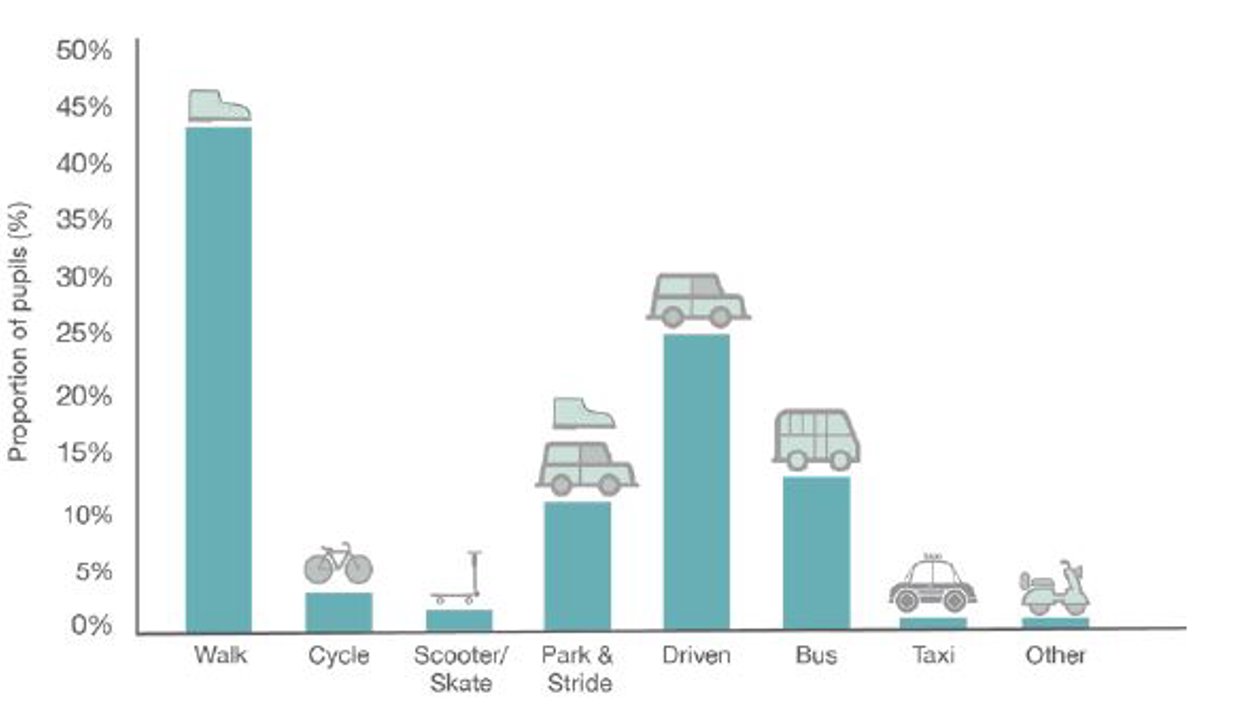
East Dunbartonshire Travel Survey 2020
The East Dunbartonshire Travel Survey was conducted in February 2020. Over 1200 responses were received. 51% of respondents who said they made journeys to school said walking was perceived as an option for them, however, only 33% of the same respondents said this was the mode of travel they used.
Similarly, 7% of respondents said travel by bicycle was an option for them travelling to school but only 2% used this mode.
General Information
- 39 town and village centre car parks
- Five Rail stations with associated parking facilities, Bearsden, Hillfoot, Lenzie, Milngavie and Westerton
- 5,413 Blue Badges on issue in East Dunbartonshire
- 15 electric vehicle public charging locations
- 1 hour 45 minutes -the average time of an electric vehicle charging session.
- Two Air Quality Management Areas in East Dunbartonshire
- A809 Corridor in Bearsden
- A803 Corridor in Bishopbriggs
- 32 primary schools
- Eight secondary schools
- Two Additional Support Needs Schools
Parking Management and Enforcement
In order to relieve or prevent congestion of traffic, the Council has a number of off-street parking places, commonly known as car parks. The Council operates a car park charging scheme in East Dunbartonshire. There have been two key phases to the development of this charging scheme which has shaped how it currently operates:
Phase 1 charging
Responses to the consultation held on the East Dunbartonshire Economic Development Strategy in 2016 indicated that a lack of parking in town centres was an issue for town centre users and local business owners. To increase turnover of the car parks and increase footfall in town centres, the Council introduced a car park charging scheme to seven town centre car parks in July 2016.
The car park charging scheme was enforced by the Council through its Decriminalised Parking Enforcement (DPE). Therefore, the income from the charging scheme was used to fund the operation of DPE with any additional monies used firstly for the provision and maintenance of off-street parking facilities and secondly for general traffic management and public transport purposes in the local authority area. As shown on the graphs below, the Council’s DPE expenditure was greater than the income in 2016/17 and 2017/18 and therefore small losses were recorded.
Phase 2 charging
To further increase turnover in the seven town centre car parks and to improve the annual balance of the Council’s DPE, the car park charging scheme was amended in June 2018. Two further car parks have since been added to the scheme.
Pre-charging: Prior to July 2016 it was free to park in any public car park in East Dunbartonshire.
Phase 1 charging – July 2016: The charging scheme operated 9am-
5.30pm Monday to Friday, with the following charges incurred for the user:
• 0-2 hours = Free
• 2-3 hours = £1
• 3-4 hours = £2
• Over 4 hours = £5.
Phase 2 charging – June 2018: The charging scheme currently operates 9am-5.30pm Monday to Saturday with the following charges
incurred for the user:
• 0-2 hours = £1
• 2-3 hours = £2
• 3-4 hours = £3
• Over 4 hours = £5.
Operation and finance of the car park charging scheme
Nine town centre car parks are currently included in the car park charging scheme. These car parks, listed within this table and other available parking in town centres can be viewed on maps included within Appendix B.
The Council monitors the use and income received through operation of Pay & Display in these car parks. The Council is required to record and report on the level of income generated and expenditure spent through operation of Decriminalised Parking Enforcement.
Income from DPE: Operation of Pay & Display and money received from Penalty Charge Notices (PCNs)
Expenditure for DPE: Operational costs including staffing and infrastructure maintenance
Pay & Display Car Parks and Free Council Car Parks
| Town | Pay & Display Car Parks (spaces) | Free Council Car Parks (spaces) |
|---|---|---|
|
Bearsden |
Bearsden Hub (25) |
Glebe (83) |
|
Bishopbriggs |
Kenmure Drive (61) |
Bishopbriggs Hub & |
|
Kirkintilloch |
Barleybank (86) |
Catherine Street (23) |
|
Milngavie |
Douglas Street (58) |
Stewart Street (South) (19) |
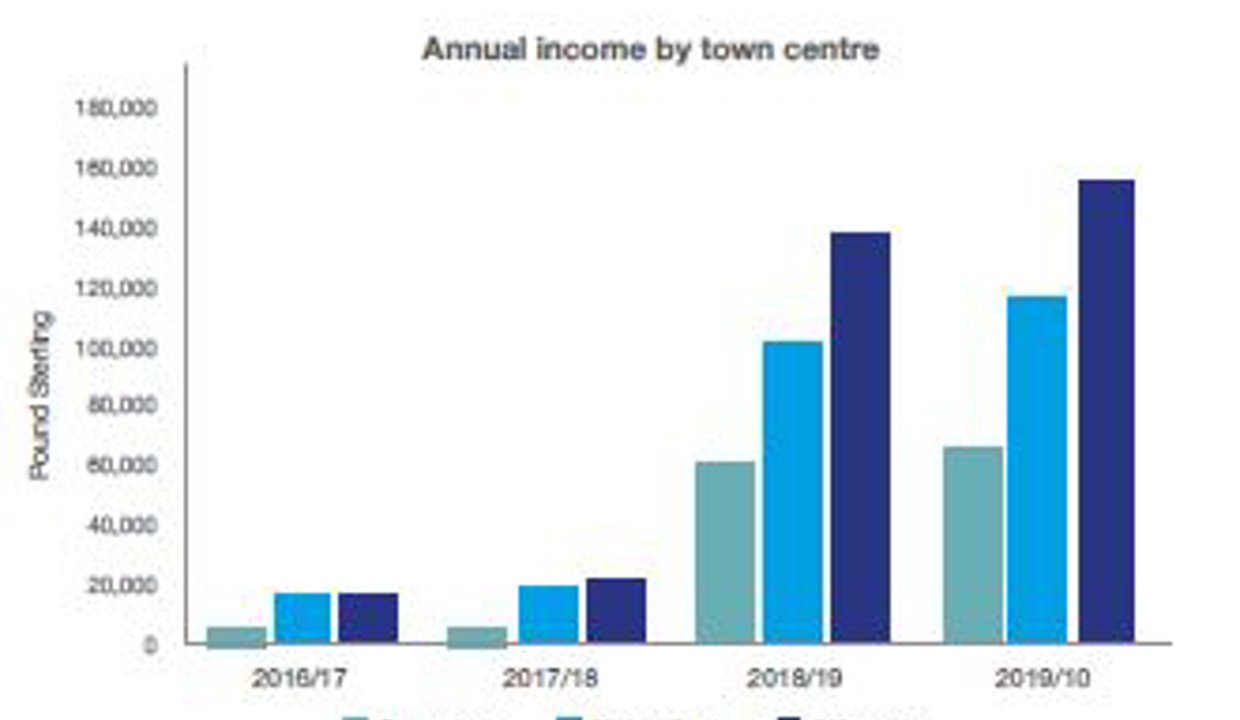
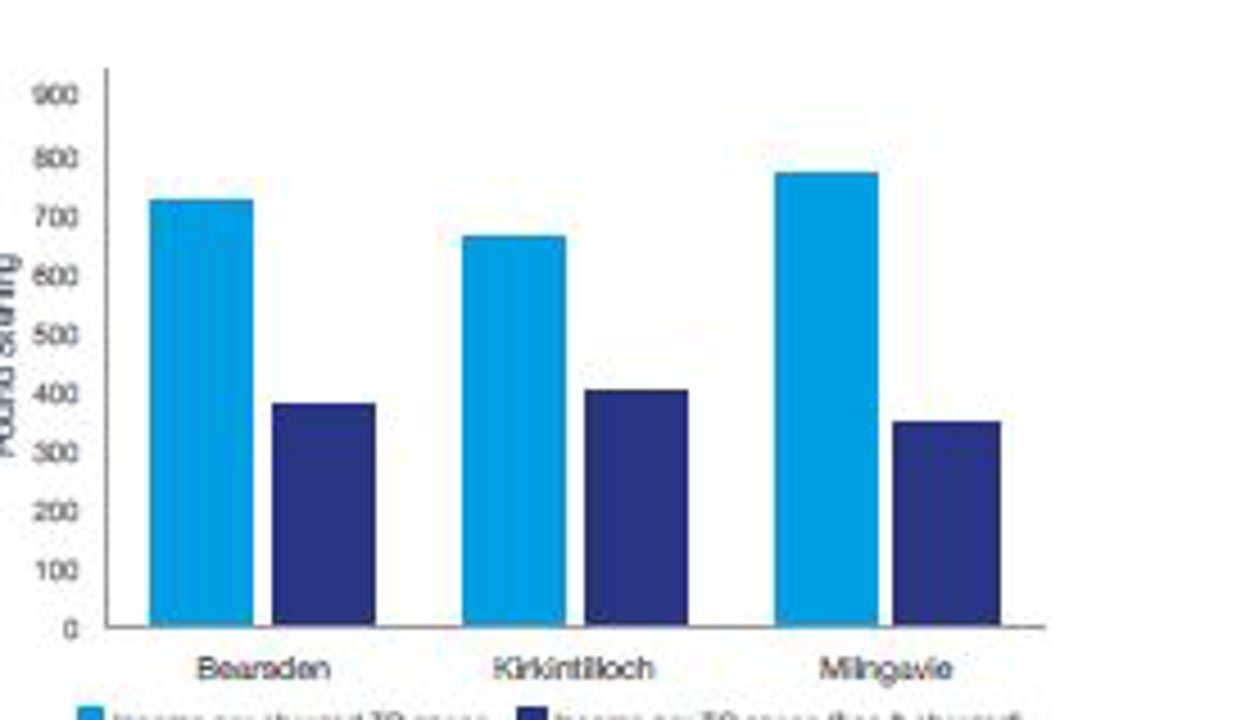
The figures above show that for years 2016/17 and 2017/18 the Council’s DPE was spending more than the generated income and was therefore making a small loss. However, in 2018/19 and 2019/20 there was a positive annual balance following the change to Phase 2 of the car park charging scheme and an increase in the number of PCNs issued by the Council. As stated in legislation, any financial surpluses must be used firstly for the provision and maintenance of off-street parking facilities and secondly for general traffic management and public transport purposes in the local authority area. The Council has therefore been able to use surpluses to provide an increased budget for sustained and increasing investment in roads network maintenance.
The figures also illustrate the income received by town centre and per space within each town centre. Milngavie provides the highest level of income from Pay & Display operation, however Milngavie also has the highest number of car park spaces (charged and free). Therefore, dividing the town centre annual income by the number of spaces available shows that proportionally, each space in Milngavie provides slightly lower income than total spaces in Bearsden and Kirkintilloch.
Effect of Pay & Display on town centre footfall
Consultation responses in recent years have raised concerns that removal of free parking in the Pay & Display car parks has reduced town centre footfall and harmed local businesses. Analysis was carried out to determine what effect the car park charging scheme has had on local town centre footfall, the results are shown below.
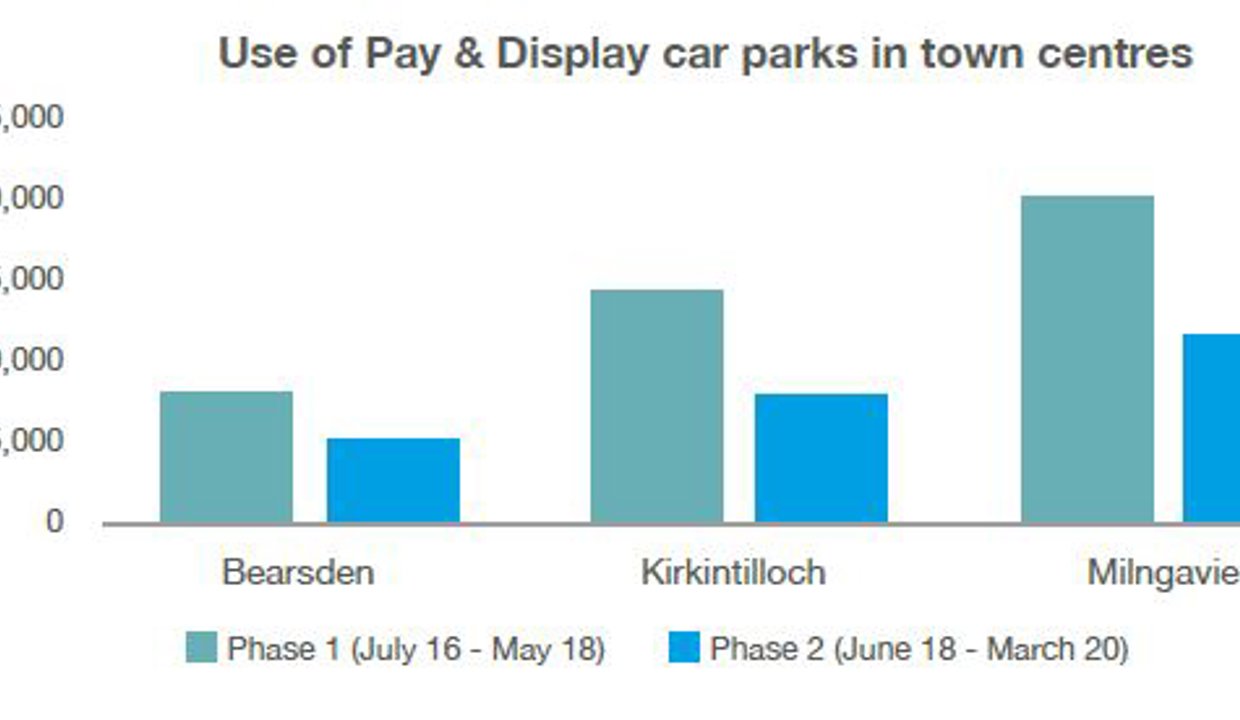
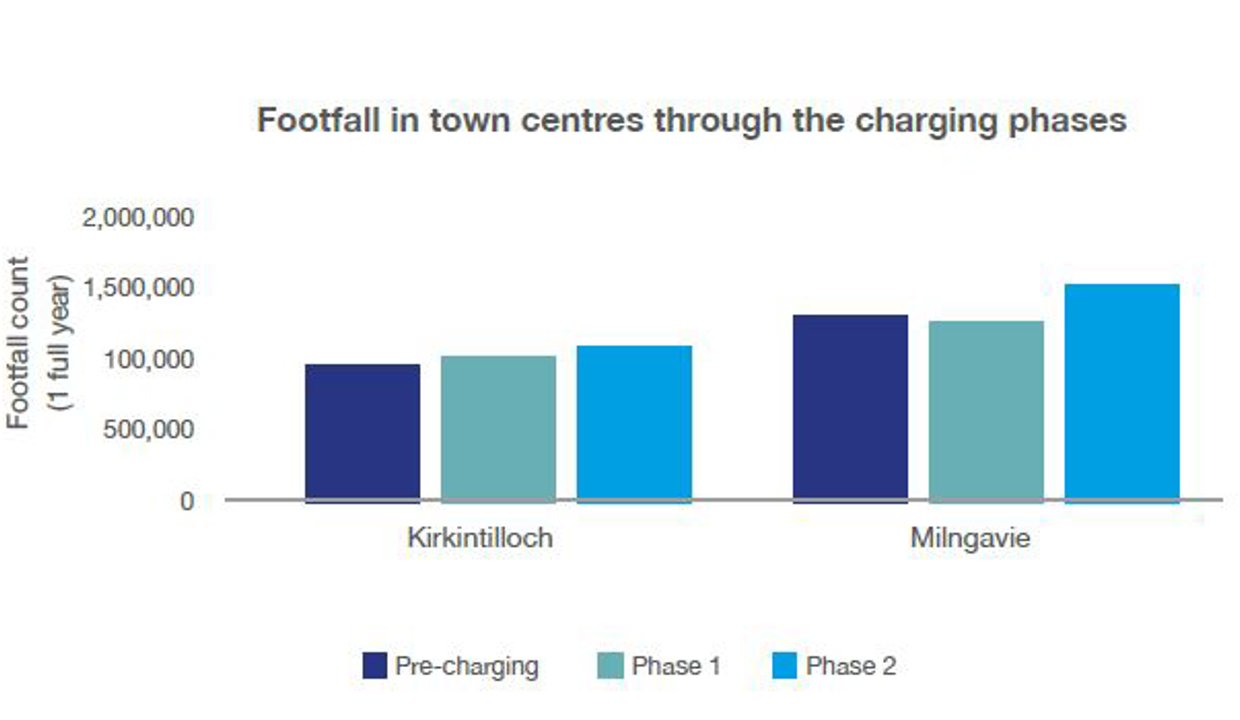
A reduction in use of the Pay & Display car parks in Bearsden, Kirkintilloch and Milngavie following the implementation of Phase 2 has been recorded. The use of car parks in an average month in Phase 2 compared to an average month in Phase 1 for each town centre is as follows:
- Bearsden down 34%
- Kirkintilloch down 43%
- Milngavie down 42%
The next step is to determine if this reduction in recorded car park use had an effect on footfall in the town centres. The Council has automatic footfall counters in each town centre. However, an issue was observed in the counter located in Bearsden from July 2018 onwards therefore this analysis focuses on Kirkintilloch and Milngavie town centres.
This graph shows recorded footfall using one full year of data at different stages of the charging phase. It can be observed that other than a small 3% reduction in Milngavie following the implementation of Phase 1, footfall has remained steady and increased in both town centres following the implementation of Phase 2. This analysis does not suggest that Phase 2 was the reason for this increase in footfall but illustrates that footfall has sustained.
Correlation analysis was undertaken using monthly figures of car park use and footfall in both town centres. There was no statistically significant correlation between the use of the Pay & Display car parks and town centre footfall in either Kirkintilloch or Milngavie.
Consultation and Responses
These points are the main parking outcomes from a range of previous consultations held by the Council including: Economic Development Strategy (2016), Transport Options Report (2018), Draft Local Transport Strategy (2019) and Draft Parking Management Plan (2021).
Schools:
- Inconsiderate and illegal parking around schools is causing safety
concerns for parents and children - Explore and pilot traffic-free schools.
Overall and residential areas:
- Pavement parking is an issue, especially around schools and in residential areas
- Parking in narrow residential streets causes problems for residents and bus operators.
Town Centres:
- Lack of parking and removal of free parking in town centres highlighted as an issue by town centre users and business owners
- Selfish and inappropriate parking is a major issue.
Rail Stations:
- Commuter parking on nearby streets to rail stations is a problem for local residents
- Parking capacity at rail stations is inadequate
What is the evidence showing?
Schools:
- 37% of school pupils driven to school with 25% dropped off close to the school entrance
- Walking and cycling is an option for some pupils and parents who are currently taking the car
- Inconsiderate and illegal parking around schools is causing safety concerns for parents and children.
Residential and overall in East Dunbartonshire:
- Ageing and growing population
- High levels of car ownership
- Growing number of Ultra Low Emission Vehicles
- Concerns around pavement and inconsiderate parking
- High level of cars being used for travelling to workplaces in East Dunbartonshire
- DPE is becoming more self-sufficient.
Town centres:
- There are Air Quality Management Areas in Bishopbriggs and Bearsden town centres
- Footfall has sustained in town centres following the implementation of parking charges
- Morning is the busiest time for tickets being purchased in the majority of Pay & Display car parks
- Concerns around pavement and inconsiderate parking.
Rail stations:
- Station car parks operating at or above capacity from early morning peak
- Commuter parking on nearby streets is a problem for local residents.
Existing Policy
Schools:
-
Local Outcome 3 of the East Dunbartonshire Local Outcomes Improvement Plan (LOIP) is “Our children and young people are safe, healthy and ready to learn”
-
A key way of staying healthy is to stay active by walking and cycling to school. The Active Travel Strategy contains a number of actions intended to support pupils and parents walk and cycle more to school through infrastructure actions and behaviour change programmes. This can reduce the volume of cars parked in close proximity to school gates.
Residential and overall in East Dunbartonshire:
-
Local Outcome 4 of the LOIP focuses on East Dunbartonshire being a safe place in which to live, work and visit. This includes ensuring people can live and access places and services safely through managing a safe, local road network, including parking across the authority area.
-
A number of actions are already in place within the Local Transport Strategy (LTS) intended to provide a more attractive alternative to travel by private car. This can reduce parking issues by minimising the volume of cars accessing key locations.
Town centres
-
Local Outcome 1 of the LOIP aims for East Dunbartonshire to have busy town and village centres
-
East Dunbartonshire’s Economic Development Strategy 2017-2020 highlights town and village centres as priority areas for economic development and includes three objectives for achieving this, including: “Creating places that are active, accessible and attractive by ensuring towns are physically appealing, pedestrian friendly, well-connected to local assets and have good quality spaces and infrastructure.
Rail Stations
-
The Transport Planning Objectives of the LTS centre on generating a shift to sustainable modes of travel including public transport and active travel. Increasing access to rail is therefore a key component of achieving this objective
-
The LTS includes an action to investigate ways of increasing parking provision at the four stations in the Bearsden and Milngavie area to deal with capacity issues. The LTS also includes a commitment for a new Active Travel Strategy that will include a focus on delivering safe, high quality active travel links to rail stations which will encourage people to travel to stations without driving.
Parking Policies and Supporting Actions
Overarching parking policies for East Dunbartonshire
Parking management and enforcement
Policy
Operate a Parking Management Hierarchy. The Parking Management Hierarchy will form the basis for decision making. The Hierarchy is shown below.
Policy link to the Local Transport Strategy Transport Planning Objectives
Delivering this Policy
The monitoring stage will involve gathering evidence to inform decision making. This evidence gathering will include:
- Site visits – these visits will determine road widths, footway widths and current parking issues over a several visits at different times of the day
- Consultation analysis – the Council will include comments from residents, road users and responses to the Local Transport Strategy consultation to help inform the decision-making process
- Incident analysis – the Council will also include information from recorded road traffic incidents as part of this process.
Delivery of a Traffic Regulation Order for the appropriate restriction will include the following key steps:
- Drafting of the Order alongside supporting documentation
- Issuing of the Order to statutory consultees for comments
- Following Council Committee approval, make the Order available for public inspection as indicated in the Public Notice
- If there are no objections, a Report will be placed before the Council Committee recommending the “making” of the Order
- If there are objections, the Council will write to the objectors with a response to their comments
- If the objections are still maintained, a Traffic Management Appeals Board is convened and those who maintained their objections are invited to attend
- A Report is then placed before the Council Committee with Traffic Management Appeals Board recommendations for the “making” of the Order
- The Council will then promote the made Order with an effective date
- This will be promoted to statutory consultees and made available for public inspection as indicated in the Public Notice
- There is then a period of six weeks from the making of the Order during which anyone may go to the Court of Session questioning the validity of the Order
- Finally, following the period of six weeks, the Council will then carry out appropriate signing and lining as set out within the Order.
Policy
Carry out enforcement on restrictions that have been made through the Parking Management Hierarchy. The Council will enforce parking restrictions through its Decriminalised Parking Enforcement.
Delivering this Policy
Enforce through community wardens:
- Community Wardens patrol on a daily basis across East Dunbartonshire – particularly in and around town centres and off-street charging car parks. The Council has recently recruited four additional dedicated Parking Wardens to assist in these efforts
- Where complaints are received in residential areas, including on-street disabled bays and in and around the school estate, ad-hoc patrols will be carried out
- Enforcement action will be taken by officers in the Community Safety Team where offences are witnessed and there is valid Traffic Regulation Order and appropriate lining and signing. The enforcement action will include where vehicles are observed parking illegally on yellow lines, parking within off-street charging car parks without following the rules of said car parks, parking illegally within enforceable disabled bays and parking illegally outside the school estate.
Parking Management Hierarchy
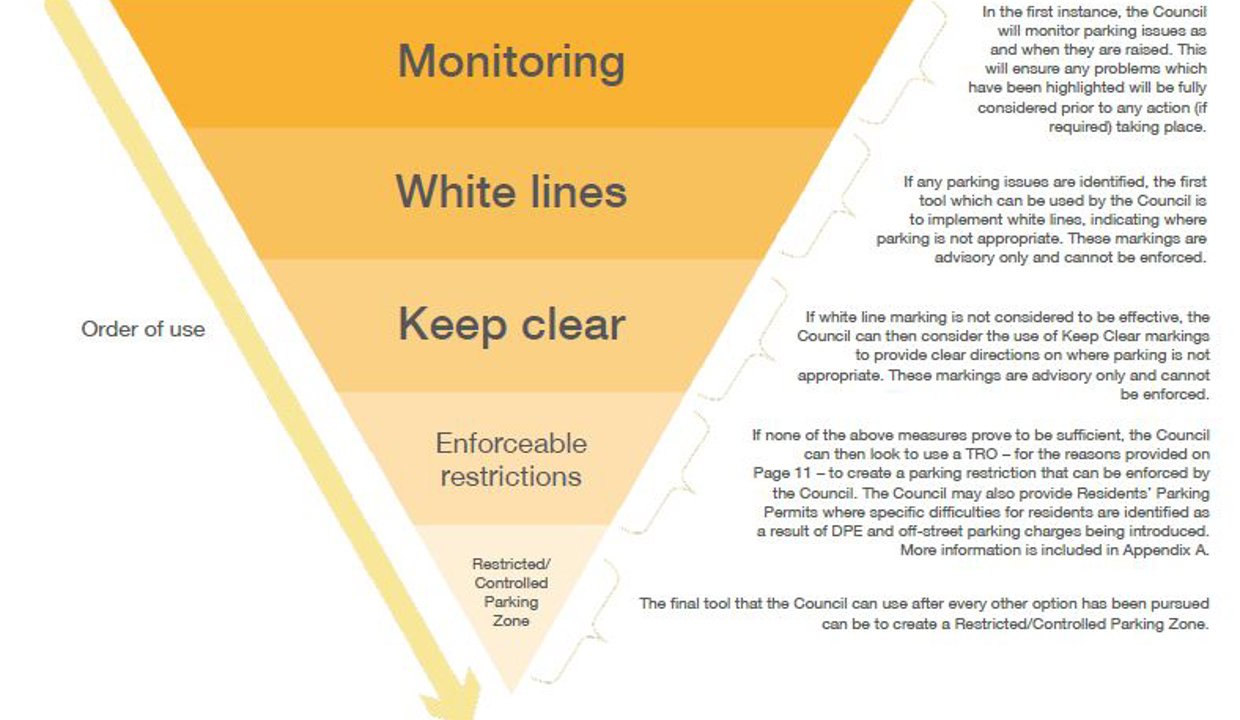
Policy
Carry out the implementation and enforcement of the parking prohibitions as part of the Council’s duties as set out in Part 6 of the Transport (Scotland) Act 2019. Policy link to the Local Transport Strategy Transport Planning Objectives
Delivering this Policy
Once the Scottish Ministers have set the secondary regulations, the Council will review these and any associated guidance to review what action will be required by the Council.
Should the Council consider it appropriate and the regulations allow it, the Council can create exemption orders for specific footways which will mean they are not included in the national pavement parking ban.
Once the new prohibitions come into force and the Council has undertaken its duties in regard to exemption orders, the Council will be responsible for enforcing the new prohibitions. This includes a ban on pavement parking, double parking and parking at dropped kerbs. This will be enforced through existing Decriminalised Parking Enforcement.
Supporting Action
Action
Work in partnership with neighbouring authorities in the Glasgow City Region to develop a regional approach to a Workplace Parking Licensing Scheme.
As summarised within Section 2 - a Workplace Parking Licensing Scheme, included within the Transport (Scotland) Act 2019, provides
local authorities with the option to require employers in the area to hold a license in order to provide parking spaces for employees.
Delivering this Action
The Council does not have plans to operate such a scheme in East Dunbartonshire. However, should neighbouring authorities implement a Workplace Parking Licensing Scheme this will have implications for residents and commuters based in the Glasgow City Region. The Council will therefore work with any neighbouring authority to assess how such a scheme would contribute to improved opportunities for sustainable travel in and out of East Dunbartonshire, contributing to the Local Transport Strategy Transport Planning Objectives.
Electric Vehicles
Policy
Support an enhanced electric vehicle public charging network.
The Council has been working with Transport Scotland to deliver
public charge points on the ChargePlace Scotland network. Further
information on the current network is included within Appendix A.
Delivering this Policy
The Council produced ‘Electric Vehicles in East Dunbartonshire’ in 2020 – a booklet which outlines plans for further charge point locations in East Dunbartonshire. Charge points will be installed in line with the delivery plan of Action 27 of the LTS.
This TRO will set out how electric vehicle charging spaces should/should not be used. Enforcement action may then be able to be taken for instances of improper use including the use of these spaces by non-charging vehicles – which blocks use of the charge point for prospective users.
Supporting Actions
Action
Increase the availability of electric vehicle charging infrastructure in line with Action 27 of the Local Transport Strategy 2020-2025.
Delivering this Action
The Council produced ‘Electric Vehicles in East Dunbartonshire’ in 2020 – a booklet which outlines plans for further charge point locations in East Dunbartonshire. Charge points will be installed in line with the delivery plan of Action 27 of the LTS.
Action
Deliver a Traffic Regulation Order to allow for enforcement to be carried out for misuse of electric vehicle charging spaces
Delivering this Action
This TRO will set out how electric vehicle charging spaces should/should not be used.
Enforcement action may then be able to be taken for instances of improper use including the use of these spaces by non-charging vehicles – which blocks use of the charge point for prospective users.
Policy
Require electric vehicle charging infrastructure to be delivered in new development.
Delivering this Policy
The Council is currently in the process of preparing its Local Development Plan 2. The Council published its Proposed LDP2 for consultation in October 2020. Policy 11 - Transport within the Proposed Plan includes a requirement for electric vehicle charging infrastructure to be delivered within new residential, employment, business and retail development sites. Work will continue in line with the Development Plan Scheme to deliver LDP2
Bicycle Parking
Policy
Support access by active travel by ensuring provision of sheltered cycle parking facilities at key locations throughout East Dunbartonshire.
While it is recognised and understood that for some people and
groups, car travel will be required in certain circumstances, there are
many short journeys that could be made by walking and cycling or by
public transport which would reduce parking pressures experienced at
key locations in East Dunbartonshire.
A number of comments received during consultation on the Draft Local
Transport Strategy requested the inclusion of cycle parking in this plan.
Delivering this Policy
This policy will be delivered through the supporting actions. Cycle parking facilities are also required as part of new development.
Supporting Actions
Action
Continue to increase the availability of secure cycle storage at rail stations and town centres.
Delivering this Action
This will be delivered in line with approach of Action 1.16 of the Active Travel Strategy
Action
Deliver increased numbers of secure cycle storage at important local facilities including: Council offices and buildings, libraries, community hubs, and community centres.
Delivering this Action
This will include assessing current availability and increasing facilities where required.
Town Centre Parking Policies
Off-street car parking
Policy
Continue to operate the car park charging scheme to ensure adequate turnover is achieved in town centre car parks and encourage journeys to town centres to be made by sustainable travel.
The consultation comments included within the evidence section
showed that a lack of parking in town centres was an issue highlighted
by town centre users and local business owners. The car park charging scheme was a tool used to enable a greater turnover within main town centre car parks.
Vehicle traffic is one of the main contributors of emissions and
particulates which can cause poor air quality. Parking charges are
therefore a tool available to encourage more people to replace shorter
journeys to town centres by walking and cycling which will benefit their
individual health and wellbeing as well as improving local air quality
which affects all residents and visitors of the four town centres.
Delivering this Policy
Continue to operate and enforce the car park charging scheme in the nine town centre car parks in line with current operations. This will include regular monitoring of car park use, income and town centre footfall.
Operation of the car park charging scheme has now been amended to allow cashless payment to be accepted. This is in response to user requests and the COVID-19 pandemic.
Blue Badge holders can park for free in all of East Dunbartonshire Council’s car parks – even where charges are in place and regardless of whether it is in a disabled bay as long as a valid disabled badge is properly displayed. You do not have to obtain a pay & display ticket.
Policy
Continue to review the scheme to determine the benefits of adding other car parks into Pay & Display operation.
Benefits include increased turnover and space availability, improving
the annual balance and operation of DPE as described in Section 3 and benefits for local air quality as outlined in Policy 7.
Delivering this Policy
Undertake regular monitoring and analysis of other town centre car parks to assess the issues facing them and consider if including them in the car park charging scheme will help address some of these issues and contribute to the overall aims and objectives of Decriminalised Parking Enforcement.
Policy
Manage all Council car parks to ensure they are used appropriately and are operating effectively.
Car parks which are not currently in the car park charging scheme
can be managed by the Council to ensure they are properly used for
the purpose they were intended, through the use of a separate Traffic
Regulation Order. This includes managing the car parks to ensure
they are not inappropriately being used for long-stay parking or for
advertising purposes.
Policy link to the Local Transport Strategy Transport Planning Objectives
Delivering this Policy
The terms of use of Council car parks are set out within an area wide Traffic Regulation Order and contravention of the provisions within the TRO can be enforced through the Council’s Decriminalised Parking Enforcement. Both of these aspects of delivering this policy will be assisted by the supporting actions
Supporting Actions
Actions
Review the existing Traffic Regulation Order for car parks not currently covered by the car park charging scheme.
Delivering this Action
Since this Order was made, some car parks and their use have either changed or no longer exist. The Council will review this Order and assess what improvements could be made to assist delivering this policy and the enforcement of improper use.
Actions
Deliver an updated Traffic Regulation Order.
Delivering this Action
The Council will use the outcomes of the review of the current Order and deliver an updated TRO in line with procedures outlined as part of Policy 1.
Policy
Suspend parking charges for events and activities that are considered to have vital importance and worth to the local economy.
Appropriate events/activities will be at the Council’s discretion.
Delivering this Policy
The Council will continue to suspend the operation of parking charges for an event/activity that satisfies any of the following criteria:
- Provides significant local economic benefits
- Is sponsored by the Council
- Where there is reasonable cause to do so, e.g. Health and Social Care Partnership activities.
Final discretion and decisions on appropriate events/activities will be made by the Council.
On-street car parking
Policy
Keep town centres clear to create places that are attractive, safe and pedestrian friendly environments that are also accessible by people who cycle.
Managing and enforcing incidences of inappropriate parking as and
when they occur is an important aspect of creating places that are
safer and cleaner for all and to encourage more people to travel to and
through town centres by walking, cycling and wheeling which can in
turn provide benefits for the local economy.
Delivering this Policy
This will be delivered by managing and enforcing parking restrictions through Traffic Regulation Orders and Decriminalised Parking Enforcement to provide more space in town centres. The supporting actions will assist the delivery of this policy.
Sufficient levels of disabled parking spaces will continue to be provided to ensure the accessibility of town centres and key facilities to all groups is retained.
Supporting Actions
Actions
Review all Traffic Regulation Orders currently in place on all streets in town centres to assess how they are functioning.
Delivering this Action
An assessment will be undertaken across the four town centres looking at where parking restrictions are in place and how they relate to other restrictions across the town centre.
Actions
Consolidate existing Traffic Regulation Orders and amend where necessary.
Delivering this Action
This exercise is intended to simplify the restrictions in place where necessary and make it easier for local users of the town centre to understand. Changes to Orders will follow the process outlined in Policy 1.
Actions
Integrate this policy into the developing plans for Bishopbriggs town centre as part of the town centre components of the Bishopbriggs Place and Growth Programme City Deal project.
Delivering this Action
The £34.88m City Deal project’s Strategic Business Case was approved by the City Deal Cabinet in February 2020, with work underway to develop the next stage of the business case. This policy will be integrated into the Bishopbriggs Town Centre regeneration component of the project. This project is included as Action 43 of the Local Transport Strategy 2020-2025.
Policy
Introduce on-street parking charges where appropriate to ensure adequate turnover is achieved in town centres
The introduction of on-street parking charges where appropriate will
assist in delivering the benefits for turnover, footfall, air quality and
improving the operation of DPE as outlined in Policies 7 and 8.
Delivering this Policy
The Council will review streets in and around town centres to consider appropriate locations for introducing on-street parking charges with the objective of ensuring improved turnover of use of the spaces and increased town centre footfall.
Following this review the Council will look to proceed with a Traffic Regulation Order to introduce on-street parking charges. The process for introducing a Traffic Regulation Order and subsequent enforcement of this Order is included within Policy 1.
Rail Station Parking Policies
Access
Policy
Support access to rail stations by active travel
Enhancing access to rail stations by active travel can reduce the
reliance on vehicle travel for shorter journeys, and ease parking
pressures in and around rail stations. The Council has delivered
improvements to Lenzie, Milngavie and Hillfoot stations and has
additional committed actions within the Active Travel Strategy and
Local Transport Strategy.
Delivering this Policy
This policy will be delivered through the supporting actions
Supporting Actions
Actions
Continue to increase the availability of secure cycle storage at rail stations.
Delivering this Action
This will be delivered in line with approach of Action 1.16 of the Active Travel Strategy
Actions
Deliver enhanced safe and accessible walking and cycling connections to rail stations and public transport links in line with the delivery plan associated with Action 7 of the Local Transport Strategy 2020-2025.
Delivering this Action
This action will be delivered through a new Active Travel Strategy. This will be produced in line with the delivery plan of corresponding Action 7 of the Local Transport Strategy 2020-2025.
Actions
Integrate this policy into the developing plans for Bishopbriggs town centre as part of the town centre components of the Bishopbriggs Place and Growth Programme City Deal project.
Delivering this Action
The £34.88m City Deal project’s Strategic Business Case was approved by the City Deal Cabinet in February 2020, with work underway to develop the next stage of the business case. This policy will be integrated into the Bishopbriggs Town Centre regeneration and A803 sustainable transport corridor components of the project. This project is included as Action 43 of the Local Transport Strategy 2020-2025.
Actions
Work with Scotland’s Railway to assess any opportunities for improving access to stations
Delivering this Action
Scotland’s Railway is currently developing a Parking and Station Connectivity Strategy which includes assessing the six stations in East Dunbartonshire which the Council will feed in to.
Policy
Manage parking issues on streets near rail stations in line with the Parking Management Hierarchy
The Council supports more people to use rail travel as it is a more
sustainable travel option. However, it is understood that the volume of
vehicles parking around rail stations can cause concern and access issues for local residents and business owners.
Delivering this Policy
The Council will follow the processes set out in Policies 1 and 2 when considering specific parking issues in neighbouring streets to rail stations.
Parking capacity
Policy
Maximise use of existing car parks and investigate opportunities for increasing capacity where appropriate
A large number of consultation comments requested increased parking capacity at rail stations. The vast majority of these comments were received from residents on the A81 corridor (Bearsden and Milngavie).
Delivering this Policy
This policy will be delivered through the supporting actions
Supporting Actions
Action
Investigate the design and implementation requirements of parking options at rail stations on the A81 corridor
Delivering this Action
This action will be delivered in line with the delivery plan associated with Action 32 of the Local Transport Strategy 2020-2025.
Action
Work with Scotland’s Railway to assess any opportunities for increasing provision within existing car park boundaries.
Delivering this Action
Scotland’s Railway is currently developing a Parking and Station Connectivity Strategy which includes assessing the six stations in East Dunbartonshire which the Council will feed in to.
Schools Parking Policies
Travel to school
Policy
Encourage and promote more journeys to be made to school by active and sustainable modes in line with the Schools Access Hierarchy.
The Council recognise and understand that in certain circumstances
car or van travel will be necessary for school, however, there are many
shorter journeys that could be made by walking and cycling. The
Council has therefore developed a Schools Access Hierarchy which
sets out the preferred order in which journeys are made to schools and includes options that can be used by the Council to help facilitate safe parking.
Delivering this Policy
The Council is committed to working with partners such as Sustrans Scotland to work in schools with pupils and teachers to encourage a positive active travel culture for journeys to schools and everyday journeys outside of school. This includes continuing the work the iBike officers do in local schools. iBike projects work in schools to get more young people cycling more often, and to encourage more active travel to school. Officers deliver a tailored programme of activities designed to bring about long-term behavioural change.
Any measure, programme or initiative that promotes active travel to and from school, such as walking and cycling “buses”, is encouraged.
In addition, the supporting action is designed to look at specific access arrangements for individual schools
Supporting Action
Actions
Ensure all schools in East Dunbartonshire are supported with information on active travel routes, initiatives and participation programmes.
Delivering this Action
Information packs will be provided to each school which will include helpful summaries of active travel information for staff, parents/guardians and pupils. This information will support staff to integrate active travel further into the school ethos and provide travel planning information to help encourage more journeys to be made in line with the Schools Access Hierarchy.
Schools Access Hierarchy
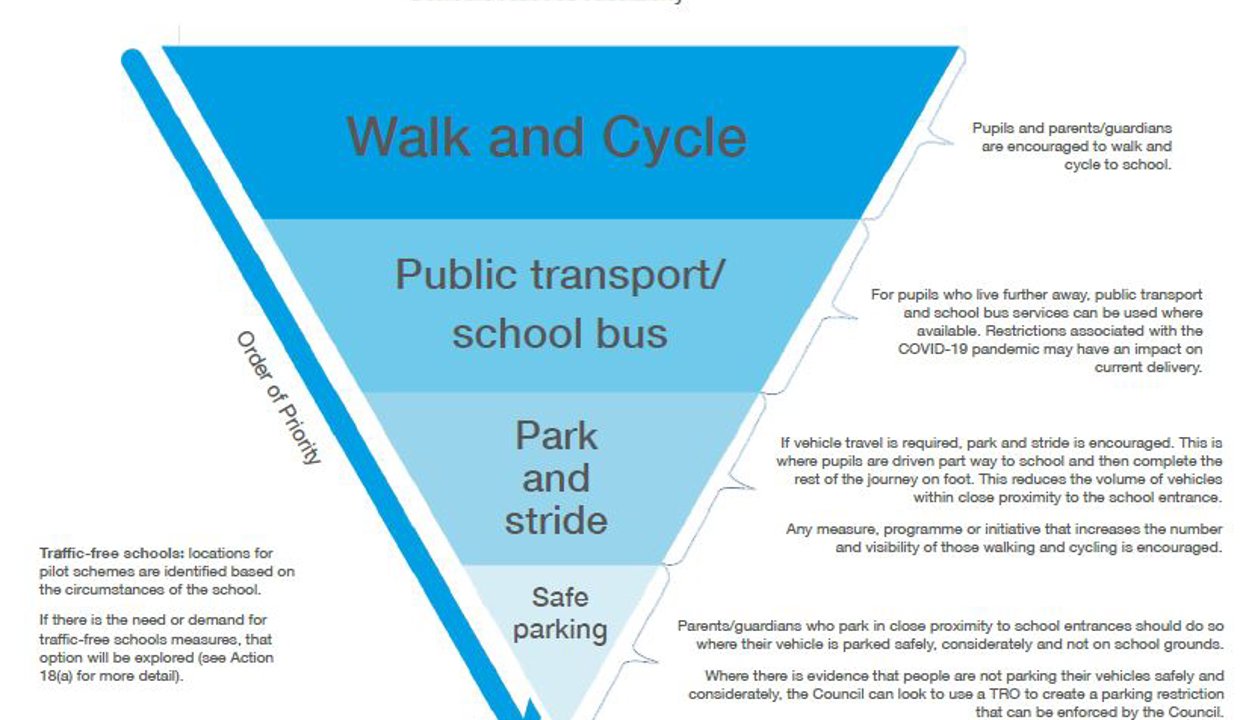
Policy
Encourage and promote responsible and safe parking in the vicinity of schools.
Cars and vans that park inconsiderately or illegally cause concern as
there are high numbers of children trying to cross the road and get to
the school entrance safely.
Delivering this Policy
Continue to deliver signage and behaviour change initiatives in and around schools. The Council currently works in schools with pupils to design eye-catching banners warning parents/guardians about the dangers of illegal and inconsiderate parking in close proximity to schools. This serious issue needs a collective response.
Policy
Consider parking restrictions in place at each school on an individual basis and assess the requirements for further enforceable restrictions in line with the Schools Access and Parking Management Hierarchies
The Council can review the conditions around schools in line with
the Parking Management Hierarchy, while taking into account local
characteristics, to explore what additional restrictions would assist the
situation and improve general safety for all involved.
Delivering this Policy
The supporting action is a step which could be taken either if parking problems pose serious safety issues or there is the will amongst the school community to promote sustainable travel. This step is also aimed at encouraging more journeys to be made by methods higher up the Schools Access Hierarchy. Every school is unique and this therefore requires each school’s suitability for further restrictions to be looked at on a school-by-school basis.
Supporting Action
Actions
Pilot a programme of traffic-free schools at appropriate school locations
The final stage in the Schools Access Hierarchy is to consider piloting
traffic-free schools where parking issues are continuing to cause
significant concern. Traffic-free schools is an initiative where small
sections of road immediately outside the entrance to schools can
be closed for short periods of time at the beginning and end of the
school day. This can improve safety by reducing the volume of vehicles
parked and moving around at the busiest spots for children and adult
pedestrians. It can also make areas nicer spaces for walking, cycling
and wheeling, encouraging more journeys to be made in this way.
A number of local authorities have conducted a pilot of this initiative.
Local primary school Parent Councils responded to the Draft Local
Transport Strategy consultation requesting the Council carry out a
similar pilot period in East Dunbartonshire.
Delivering this Action
Schools will be identified for potential inclusion within the pilot programme using a four-step selection process.
- In line with the Schools Access and Parking Management Hierarchies, in the first instance, a school will continue to step 2 if they currently have enforceable restrictions in place
- If parking problems remain, then the school will continue to step 3
- If the school and/or Parent Council is supportive of such a proposal and willing to help in its delivery the school will continue to step 4
- The final step is to assess the school location’s suitability for inclusion in such a pilot. This will be a technical assessment of the road layout and road function to determine if the school is suitable to be included in the pilot programme.
Following the four-step selection process, the final schools to be included within the pilot programme will be decided based on the scale of the parking problems that exist and the suitability of each school location to be included as a pilot school. A small number of schools will be included in the initial pilot programme.
In planning for the pilot programme the following tasks will be carried out (for each school location):
- Monitor travel behaviours to provide baseline data
- Consultation with the school including staff, parents/guardians and pupils
- Consultation with local residents
- Consultation with Police Scotland on road closures and enforcement arrangements
- Consultation with stakeholders, as appropriate, in line with road traffic statutory processes and implement any mitigation measures (if required)
- Preparation of an Experimental/Temporary Traffic Regulation Order
- Carry out communications activities to raise awareness of the pilot project arrangements as well as the projects aims, benefits and implications for local residents.
Once the Experimental/Temporary Traffic Regulation Order is in place, the pilot project will operate for a period of six months (or length of time as deemed appropriate through the various consultation exercises). The intention of traffic-free schools pilot schemes is that residents will be issued some form of accreditation and have access to their street at any time.
The pilot project will be monitored throughout to gauge success and react to any practical issues, as they arise. Monitoring will include on-site inspections and further
consultation with the school community to understand how the project has been received.
A Report will be prepared detailing the outcomes of the monitoring work and reported to the Place, Neighbourhood and Corporate Assets Committee. Recommendations for the future of the project will then be made based on the evidence of the Monitoring Report.
Appendices
Appendix A – Further information
Abandoned vehicles – Information on legislation and Council processes relating to abandoned vehicles in East Dunbartonshire can be accessed on the Abandoned vehicles web page, with an online form available to report such a matter: It should be noted that the definition of a motor vehicle within the legislation does not cover caravans that are not attached to a motor vehicle. Therefore, the Council do not have the powers to move caravans in the same way it can for abandoned vehicles.
Air Quality Management Area - An Air Quality Management Area is declared when there is an exceedance or likely exceedance of a Scottish air quality objective. East Dunbartonshire has two such areas, declared for exceedances of levels of Nitrogen Dioxide (NO2) and small particulate matter (PM10). Air quality has improved in both areas in recent years. More information can accessed on the Pollution page.
Blue Badge Scheme - The blue badge scheme supports those with a disability to lead independent lives by allowing badge holders to park close to where they need to go. The Council administers the scheme in this area and is legally entitled to issue badges only to those applicants who meet the criteria. More information on the scheme and details of how to apply are available on the East Dunbartonshire Health and Social Care Partnership website.
Electric vehicles charge point locations, plans and further information.
Local Development Plan 2 – Further information on the content and delivery of LDP2 can be accessed on the Council’s website.
Local Transport Strategy 2020-2025 and accompanying documents.
Residents Parking Permits - The Residents Parking Permit Scheme was introduced in response to specific difficulties that were identified across the council areas in regard to parking for some residents when decriminalised parking enforcement and thereafter off-street parking charges were introduced. Under the terms of the scheme applications for a Residents Parking Permit will be considered
Where a house or flat is newly built, or formed by sub-division of an existing property, the responsibility for the provision of parking lies with the developer unless specifically agreed otherwise by East Dunbartonshire Council in advance of the works taking place.
Transport (Scotland) Act 2019 – Full details of the Transport (Scotland) Act 2019 can be accessed on the UK Government’s legislation website.
Safe Walking Routes assessment – This is a term used to describe the process the Council will carry out for individual home addresses to determine an appropriate route that could be taken to the relevant school. It is an assessment made under national guidelines of the route at the time a child would use it. In this circumstance, the safe route to school is not signposted or determined the only safe route to that school as it is an individual assessment for the relevant home address.
Appendix B – Town Centre Parking Availability
Bearsden
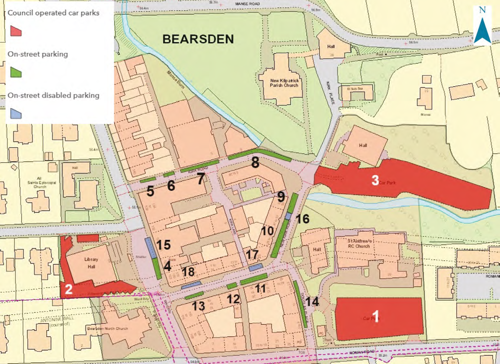
Council operated car parks Bearsden
| Map Number | Name | Number of disabled space | Total number of spaces | Type |
|---|---|---|---|---|
|
1 |
Roman Road |
4 |
67 |
Pay & Display (2016) |
|
2 |
Bearsden Community Hub |
3 |
25 |
Pay & Display (2020) |
|
3 |
The Glebe |
1 |
83 |
Free |
|
Total |
- |
8 |
175 |
- |
On-street parking Bearsden
| Map Number | Number of spaces | Type of restriction | Type of restriction | Day of restriction |
|---|---|---|---|---|
|
4 |
3 |
Short stay (20 mins) |
9am-5pm |
Mon-Sat |
|
5 |
2 |
Short stay (1 hour) |
9am-5.30pm |
Mon-Sat |
|
6 |
1 |
Short stay (1 hour) |
9am-5.30pm |
Mon-Sat |
|
7 |
5 |
Short stay (1 hour) |
9am-5.30pm |
Mon-Sat |
|
8 |
8 |
Short stay (1 hour) |
9am-5.30pm |
Mon-Sat |
|
9 |
3 |
Short stay (1 hour) |
9am-5.30pm |
Mon-Sat |
|
10 |
6 |
Short stay (1 hour) |
9am-5.30pm |
Mon-Sat |
|
11 |
3 |
Short stay (1 hour) |
9am-5.30pm |
Mon-Sat |
|
12 |
1 |
Short stay (1 hour) |
9am-5.30pm |
Mon-Sat |
|
13 |
2 |
Short stay (1 hour) |
9am-5.30pm |
Mon-Sat |
|
14 |
6 |
Short stay (1 hour) |
9am-5.30pm |
Mon-Sat |
|
Total |
40 |
- |
- |
- |
Disabled Spaces Bearsden
| Map Number | Number of spaces | Type of restriction | Type of restriction | Day of restriction |
|---|---|---|---|---|
|
15 |
2 |
Short stay (3 hours) |
9am-5pm |
Mon-Sat |
|
16 |
1 |
Short stay (1 hour) |
9am-5.30pm |
Mon-Sat |
|
17 |
1 |
Short stay (3 hours) |
8am-5pm |
Mon-Sat |
|
18 |
2 |
Short stay (3 hours) |
8am-5pm |
Mon-Sat |
|
Total |
6 |
- |
- |
- |
Bishopbriggs
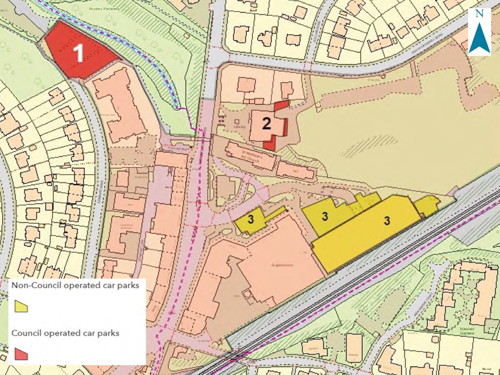
Council operated car parks Bishopbriggs
| Map number | Name | Number of disabled spaces | Total Number of spaces | Type |
|---|---|---|---|---|
|
1 |
Kenmure Drive |
3 |
61 |
Pay & Display |
|
2 |
Bishopbriggs Hub & Library |
2 |
13 |
Free |
|
Total |
- |
5 |
74 |
- |
non-Council operated car parks Bishopbriggs
| Map Number | Operator /location | Total number of spaces | Restriction |
|---|---|---|---|
|
3 |
Morrisons |
Unknown |
Customer use only (3 hours) |
Kirkintilloch
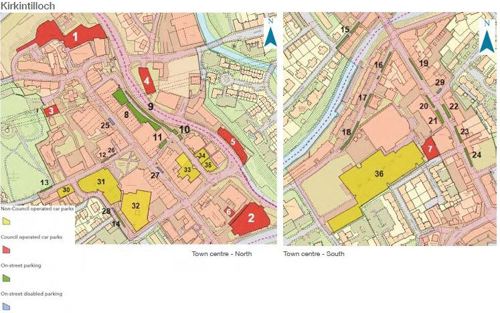
Council operated car parks Kirkintilloch
| Map Number | Name | Number of disabled spaces | Total number of spaces | Type |
|---|---|---|---|---|
|
1 |
William Patrick Library |
7 |
91 |
Pay & Display |
|
2 |
Barleybank |
4 |
86 |
Pay & Display (2020) |
|
3 |
Peel Park |
0 |
11 |
Free |
|
4 |
High Street |
0 |
34 |
Free |
|
5 |
Rochdale Place |
0 |
29 |
Free |
|
5 |
Catherine Street |
3 |
23 |
Free |
|
7 |
Shamrock Street |
2 |
19 |
Free |
|
Total |
- |
16 |
293 |
- |
On-street parking Kirkintilloch
| Map Number | Number of spaces | Type of restriction | Time of restriction | Day of restriction |
|---|---|---|---|---|
|
8 |
10 |
No restriction |
- |
- |
|
9 |
9 |
No Restriction |
- |
- |
|
10 |
6 |
No Restriction |
- |
- |
|
11 |
7 |
No Restriction |
- |
- |
|
12 |
2 |
Short stay (2 hours) |
8am-6pm |
Mon-Sat |
|
13 |
3 |
Short stay (2 hours) |
8am-6pm |
Mon-Sat |
|
14 |
6 |
No Restriction |
- |
- |
|
15 |
9 |
No Restriction |
- |
- |
|
15 |
9 |
No Restriction |
- |
- |
|
16 |
7 |
No Restriction |
- |
- |
|
17 |
4 |
No Restriction |
- |
- |
|
18 |
8 |
No Restriction |
- |
- |
|
19 |
11 |
Short stay (2 hours) |
8am-6pm |
Mon-Sat |
|
20 |
3 |
Short stay (2 hours) |
8am-6pm |
Mon-Sat |
|
21 |
5 |
Short stay (2 hours) |
8am-6pm |
Mon-Sat |
|
22 |
5 |
Short stay (2 hours) |
8am-6pm |
Mon-Sat |
|
23 |
6 |
Short stay (2 hours) |
8am-6pm |
Mon-Sat |
|
24 |
4 |
Short stay (2 hours) |
8am-6pm |
Mon-Sat |
|
Total |
105 |
- |
- |
- |
Disabled spaces Kirkintilloch
| Map Number | Number of spaces | Type of restriction |
|---|---|---|
|
25 |
2 |
Disabled only |
|
26 |
2 |
Disabled use only – Short stay (3 hours) |
|
28 |
2 |
Disabled only |
|
28 |
1 |
Disabled use only – Short stay (3 hours) |
|
29 |
2 |
Disabled use only – Short stay (3 hours) |
|
Total |
9 |
- |
non-Council operated car parks Kirkintilloch
| Map Number | Operator /location | Total number of spaces | Restriction |
|---|---|---|---|
|
30 |
Peel View Medical Centre |
Not lined |
Private parking |
|
31 |
Regent Centre (ground floor) |
90 |
Customer use only (2 hours) |
|
32 |
Regent Centre (upper floor) |
90 |
Customer use only (2 hours) |
|
33 |
David Donnelly Place |
Not lined |
Private parking |
|
34 |
Broadcroft Hotel |
10 |
Private parking |
|
35 |
Turret Medical Centre |
12 |
Private parking |
|
36 |
Sainsbury’s |
284 |
Customer use only (2 hours) |
Milngavie
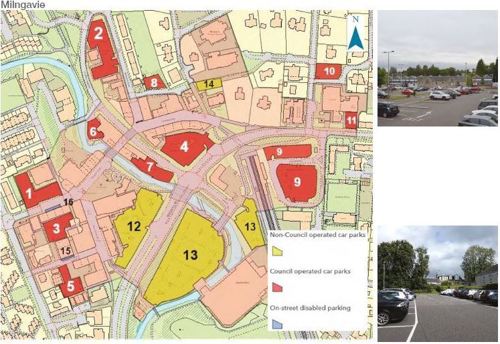
Council operated car parks Milngavie
| Map Number | Name | Number of disabled spaces | Total Number of spaces | Type |
|---|---|---|---|---|
|
1 |
Douglas Street |
4 |
58 |
Pay & Display |
|
2 |
Mugdock Road |
3 |
70 |
Pay & Display |
|
3 |
Stewart Street (North) |
3 |
21 |
Pay & Display |
|
4 |
Woodburn Way |
6 |
52 |
Pay & Display |
|
5 |
Stewart Street (South) |
3 |
19 |
Free |
|
6 |
Riverside |
0 |
15 |
Free |
|
7 |
Ellangowan |
2 |
18 |
Free |
|
8 |
Mugdock Road (East) |
0 |
17 |
Free |
|
9 |
Milngavie Station |
7 |
135 |
Free |
|
10 |
Kersland |
1 |
27 |
Free |
|
11 |
Town Hall |
2 |
18 |
Free |
|
Total |
- |
31 |
450 |
- |
Non-Council operated car parks Milngavie
| Map Number | Operator /location | Total number of spaces | Restriction |
|---|---|---|---|
|
12 |
Marks & Spencer |
115 |
Customer use (3 hours) |
|
13 |
Tesco |
360 |
Customer use (3 hours) |
|
14 |
Kersland House Surgery |
12 |
Private parking |
On-street parking Milngavie
| Map Number | Number of spaces | Type of restriction | Time of restriction | Day of restriction |
|---|---|---|---|---|
|
15 |
3 |
Short stay (3 hours) |
N/A |
N/A |
|
16 |
7 |
N/A |
N/A |
N/A |
|
Total |
10 |
- |
- |
- |
